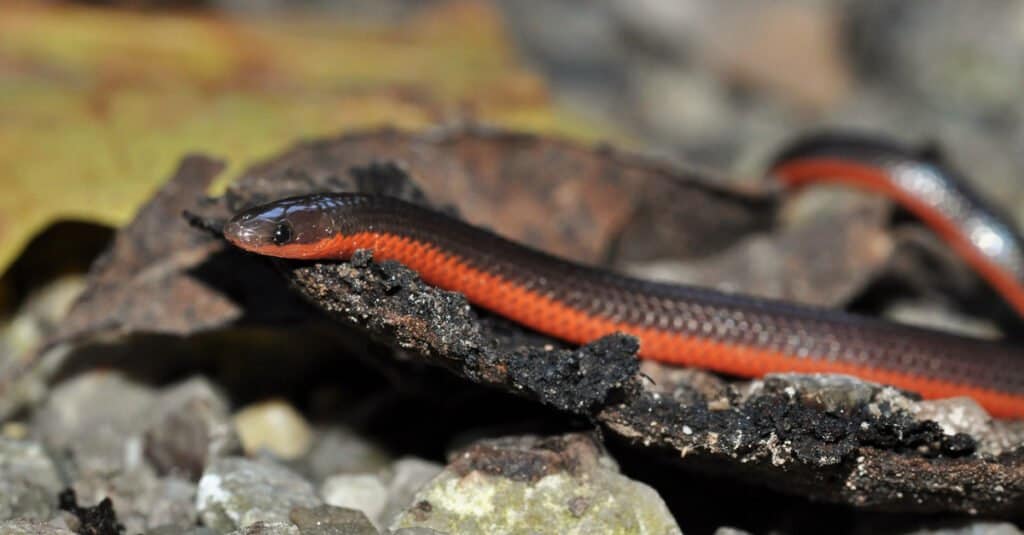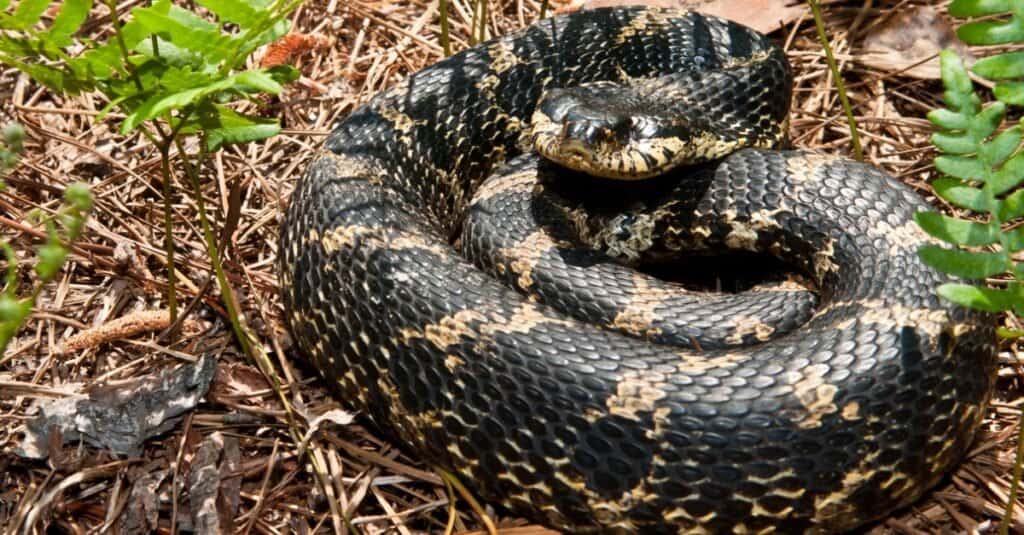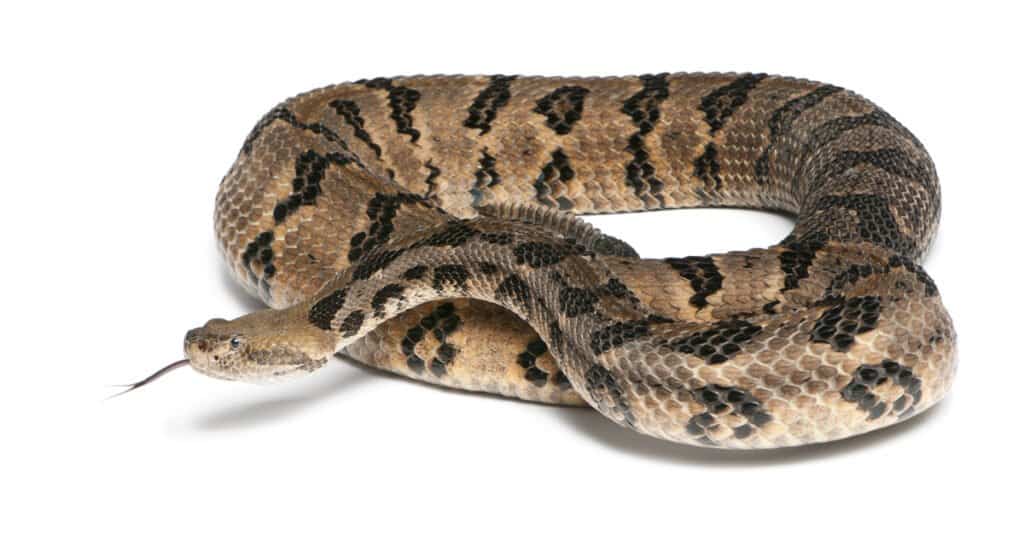Outdoor lovers don’t really have a lot to fear from the 15 types of snakes in Massachusetts. Compared to other states, Massachusetts has a relatively low number of snakes and none of the snakes that you will find in Massachusetts are particularly aggressive. There are two types of venomous snakes in Massachusetts, however, it’s very rare to come across any venomous snakes in this state. In most cases, if you do see snakes in Massachusetts they will be small and harmless. If you don’t bother them they won’t bother you.
So, let’s run down some of the most familiar snakes in Massachusetts, and then we’ll profile the two snakes in the state that can be venomous!

Non-Venomous Snakes in Massachusetts
Even though it’s not very common to see any snakes while you are out in Massachusetts if you do a lot of hiking, camping, or hunting you may occasionally run into one of these types of snakes. While these snakes are not venomous, it’s always best to leave snakes alone in the wild even if they are not a grave threat.
1. Eastern Black Racer

The black racer is agile and can “run” (crawl) four miles per hour when it is threatened, hence the name “racer.”
©Breck P. Kent/Shutterstock.com
Eastern black racer snakes are extremely fast. These snakes are mostly one color, usually black or brown, but their bellies may be lighter than their backs. Because they are so quick in most cases you will only get a glimpse of movement. They disappear before you even get a good look at them.
Eastern black racers prefer to hang out in brush piles and tall grass but they can lift up their heads to see over any obstructions in their way. If you see a snakehead looking over at you through some tall grass it’s probably an eastern black racer snake. Sometimes their tails can vibrate when they feel threatened and those vibrations can make leaves and grass rustle. You may hear a sound like a rattle but these snakes don’t have rattles and are not venomous.
2. Eastern Worm Snake

Worm snakes are usually quite small.
©Mike Wilhelm/Shutterstock.com
If you see something moving in the grass that looks like a giant worm it’s probably an eastern worm snake. Worm snakes are very small. They are about a foot to a foot-and-a-half long. They have pale pinkish grayscales that look like the dirty pink color of an earthworm. Earthworms are their primary food source but they eat other small creatures as well. Eastern worm snakes are threatened in Massachusetts. In fact, the Massachusetts Endangered Species Act makes it illegal to kill one.
3. Eastern Hognose Snake

The eastern hognose snake uses its snout to hunt for prey in soil.
©iStock.com/JasonOndreicka
These unique snakes can be easily identified by their odd upturned prominent snouts. They don’t look like any other type of snake. But the eastern hognose’s distinctive snout has a purpose. It prefers to be in sandy soil, like the kind near water, and it uses that special snout to dig for prey in the loose sandy soil.
There is no set color palette for the eastern hognose. It can be dull colored black or brown, or brightly colored red, yellow, or green. The eastern hognose hisses at a potential threat if it is scared. But it is more likely to play dead to get a predator to leave it alone than it is to strike out.
4. Brahminy Blind Snake

Brahminy blind snakes may get into homes via potted plants, or crawling under doors or through cracks.
©Patrick K. Campbell/Shutterstock.com
These tiny snakes are the smallest-known snake species. They are generally just a few inches long, and almost never over six inches long. You may not even realize it’s a snake if you see one because they are so tiny. Brahminy blind snakes are fast and try to avoid being seen. Blind snakes like to hide in leaves and grass piles so you might come across them when you are raking leaves in the fall or mowing grass in the spring and summer. Small blind snakes like to be underground where they can feed on termites and ants.
5. Ribbon Snake

Ribbon snakes are commonly found around Massachusetts.
©Steve Bower/Shutterstock.com
Ribbon snakes are a type of garter snake. Like a traditional garter snake, they have a bright color pattern on a dark body. Usually, ribbon snakes have bright yellow stripes on a dark brown body. Ribbon snakes like an aquatic environment and feed on aquatic animals. So, if you see one, it’s most likely going to be around marshes, ponds, wetlands, rivers, or lakes. Because of the fierce Massachusetts winters, ribbon snakes go into hibernation from around October until around April or whenever the water starts to thaw out from winter freeze.
Venomous Snakes in Massachusetts
There are venomous snakes in Massachusetts but only these two types of snakes, and most people never see them. It’s very rare to ever come into contact with a venomous snake in Massachusetts. Let’s examine both of them while bearing in mind they’re rarely seen across the state:
6. Northern Copperhead
The northern copperhead snake is one of the largest snakes in Massachusetts. It has a heavy wide body and can grow up to be almost five feet long. Typically, snakes in Massachusetts are on the smaller side and stay around three feet long. This snake has a distinctive hourglass pattern on the body that can you help you identify it.
Copperheads usually are light-colored with dark markings. They also can have dark bodies. But the northern copperhead has one very distinctive feature. The snake’s head is a deep red color which makes identifying it from a distance easy. If you hear a rattle and see that red head make sure that you slowly back up and get out of the area. Northern copperheads are protected in Massachusetts. It’s illegal to kill one.

The northern copperhead has hour-glass shaped bands down its body.
©iStock.com/David Kenny
7. Timber Rattlesnake
Timber rattlesnakes prefer to stay in forested areas and are only active during the late spring, summer, and fall. They hibernate during the winter months. Like the northern copperhead, the timber rattlesnake is very rare in Massachusetts. And like the northern copperhead, it’s illegal to kill or abuse one. Timber rattlesnakes can grow to be about five feet long but they have a thinner body than the northern copperhead.

Timber rattlesnakes are present but very rarely seen in Massachusetts.
©Eric Isselee/Shutterstock.com
Summary of Snakes in Massachusetts
Here’s a recap of the snake species present in Massachusetts that we took a look at:
| Number | Snake | Type |
|---|---|---|
| 1 | Eastern Black Racer | Non-venomous |
| 2 | Eastern Worm Snake | Non-venomous |
| 3 | Eastern Hognose Snake | Non-venomous |
| 4 | Brahminy Blind Snake | Non-venomous |
| 5 | Ribbon Snake | Non-venomous |
| 6 | Northern Copperhead | Venomous |
| 7 | Timber Rattlesnake | Venomous |
A Complete List of the Different Snakes in Massachusetts
Most of the snakes that you will see in Massachusetts are small and non-threatening so there’s no reason to be afraid of them. Just remember that even though the snakes in Massachusetts are almost all harmless snakes; they’re still wild animals. Any wild animal can attempt to bite or strike if you get too close or if you surprise it in some way. So if you come across a snake in Massachusetts, just calmly go on about your business and keep your distance.
The full list of 15 snakes that you’ll find in Massachusetts includes:
- Northern copperhead snake
- Black racer snake
- Timber rattlesnake
- Eastern worm snake
- Ring-necked snake
- Eastern hognose snake
- Eastern milk snake
- Northern water snake
- Smooth green snake
- Black rat snake
- Brown snake
- Brahminy blind snake
- Northern redbelly snake
- Ribbon snake
- Common garter snake.
The photo featured at the top of this post is © Gerald A. DeBoer/Shutterstock.com
Discover the "Monster" Snake 5X Bigger than an Anaconda
Every day A-Z Animals sends out some of the most incredible facts in the world from our free newsletter. Want to discover the 10 most beautiful snakes in the world, a "snake island" where you're never more than 3 feet from danger, or a "monster" snake 5X larger than an anaconda? Then sign up right now and you'll start receiving our daily newsletter absolutely free.
Thank you for reading! Have some feedback for us? Contact the AZ Animals editorial team.






